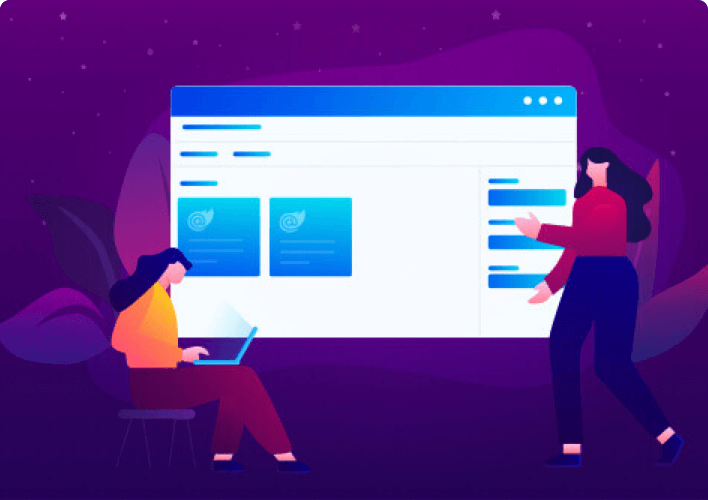
Why you need the Syncfusion Blazor component library
The Syncfusion Blazor component library offers 145+ responsive, lightweight components, including data visualizations like DataGrid, 55+ Charts, and Scheduler, for building modern web apps.

145+ Blazor components
The Syncfusion Blazor Component Library offers 145+ components that work seamlessly with both Blazor Server and client-side Blazor WebAssembly projects.

AI-ready UI components
From AI-ready components to AI-powered services like the HelpBot and Code Studio, Syncfusion helps you build intelligent apps faster and get support when you need it.

Stunning built-in themes
Pixel-perfect built-in themes are available in Fluent 2, Tailwind CSS, Bootstrap 5, and Material 3 designs. You can customize these themes using our online Theme Studio tool.

Performance
Every component is fine-tuned to work with a high volume of data.

Dedicated support
Truly unlimited dedicated support system via the public forum, feature & feedback page, live chat, and support tickets.

Demos and training
A wide range of product demos and training, including video tutorials, documentation, and KBs.

Hassle-free licensing
Simple, straightforward, and no hidden fees. Guaranteed.
AI-Powered Tools for Developers
Explore the complete Syncfusion® AI ecosystem: AI-ready UI components, smart developer tools like Code Studio (an AI code editor) and instant support with the AI-powered HelpBot. Everything you need to build intelligent, modern apps faster.
Explore Our AI ToolsAI Coding Assistant
The Syncfusion AI Coding Assistant boosts Blazor web app development with intelligent, context-aware code suggestions tailored to Syncfusion components. Easily integrate and configure projects in AI-powered IDEs like VS Code, Cursor, Syncfusion Code Studio, and more.
Get Started with AI AssistantMost Popular Blazor UI components
145+ Blazor UI & DataViz Components
260+ Prebuilt Blazor Blocks
The Essential® UI Kit for Blazor is your gateway to building stunning web applications effortlessly. With over 260 professionally designed, responsive, and composable blocks, you can accelerate development while maintaining a clean, modern aesthetic.
LEARN MORELearn more essential blazor ui kitSyncfusion Blazor Tutorials, Blogs, and Testimonials

CASE STUDY
Easily Transition from Desktop to Web Development with Syncfusion Blazor Controls.
Read Case Study →Frequently Asked Questions
Why should I choose Syncfusion Blazor components?
- 145+ Native Blazor components including DataGrid, Charts, Scheduler, and Diagram with rich feature set.
- Supports both server-side and client-side (WebAssembly) applications.
- All the components are touch friendly and render adaptively based on the device, providing an optimal user experience on phones, tablets, and desktops.
- Easily build applications for global audiences with various languages and cultures.
- They're some of the best Blazor components on the market that offer feature-rich UIs to interact with your software.
- Complete learning resources such as demos, documentation and videos help you understand the component easily.
- Fast responsive support through support, Community Forum, and Feedback.
- Syncfusion Blazor component library NuGet packages are available in NuGet.org for easy development process.
Can I download and use the Syncfusion Blazor component library for free?
No, this is a commercial product and requires a paid license. However, a free community license is also available for companies and individuals whose organizations have less than $1 million USD in annual gross revenue, 5 or fewer developers, and 10 or fewer total employees.
How do I get started with Syncfusion Blazor components?
A good place to start would be our comprehensive getting started documentation.
Where can I find the Syncfusion Blazor components demos?
You can find our Blazor component library's complete tutorial and showcase demos hereBlazor demos.
Can I deploy an application that uses Syncfusion Blazor components to unlimited clients?
Yes, you can deploy an application that uses Syncfusion Blazor components or controls to unlimited clients. We only license on a per-developer basis and do not charge any runtime, royalty, or deployment fees. More details on our licensing model can be found hereMore about licensing.
You might find it helpful

Blazor EBook
A quick guide to getting started with learning and improving your skills using Blazor technology.
Get your free ebook →
Blazor Webstories
Explore our collection of web stories to learn about programming and development tools.
Explore Webstories →Our Customers Love Us


Recent activities in Blazor tutorials and blogs
The Blazor tutorial videos and blog posts will guide you in creating your first app with the Blazor components. They'll give you problem-solving ideas, describe features and their functionality, announce the new feature availability, explain Blazor components best practices, and describe example scenarios using the Blazor components. Check out our recent activity on our blog and tutorial video channels for Blazor.



























